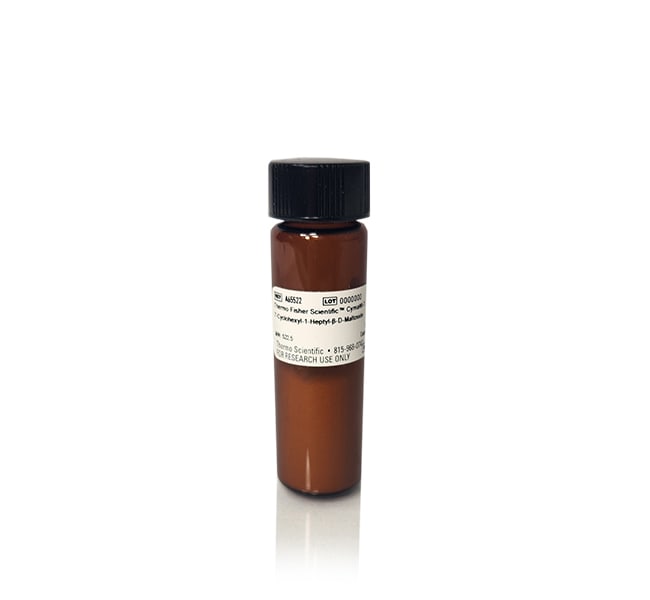Search Thermo Fisher Scientific
- Contáctenos
- Orden Rápida
-
¿No tiene una cuenta? Crear una cuenta
Search Thermo Fisher Scientific

| Número de catálogo | Descripción | Cantidad |
|---|---|---|
| A65522 | 7-Cyclohexyl-1-Heptyl-β-D-Maltoside (Cymal-7) | 1 g |
| A65517 | 5-Cyclohexyl-1-Pentyl-β-D-Maltoside (Cymal-5) | 1 g |
| A65518 | 5-Cyclohexyl-1-Pentyl-β-D-Maltoside (Cymal-5) | 5 g |
| A65520 | 6-Cyclohexyl-1-Hexyl-β-D-Maltoside (Cymal-6) | 1 g |
| A65521 | 6-Cyclohexyl-1-Hexyl-β-D-Maltoside (Cymal-6) | 5 g |
| A65523 | 7-Cyclohexyl-1-Heptyl-β-D-Maltoside (Cymal-7) | 5 g |
Features of cyclohexyl maltoside detergents
• Gentle—preserves the native conformation and activity of membrane proteins
• Enhanced stability during extraction and downstream applications
• High-purity with low UV absorptivity
Overall, cyclohexyl maltoside detergents are versatile and can be used in various experimental techniques, including protein purification, crystallization, spectroscopy, and structural biology studies. They are compatible with a wide range of biomolecules and can be employed for both soluble and membrane protein research.
5-Cyclohexyl-1-Pentyl-β-D-Maltoside
5-Cyclohexyl-1-Pentyl-β-D-Maltoside (Cymal-5) has a specific combination of a cyclohexyl and pentyl alkyl chain attached to the maltose moiety. This combination of alkyl chains can enhance the detergent's hydrophobicity, solubilization properties, and interactions with certain types of membrane proteins. Cymal-5 is often utilized for solubilization and stabilization of membrane protein complexes. The solubilization efficiency allows for the extraction of intact complexes, helping to preserve their native structure and functionality. It is important to note that the specific solubilization efficiency of Cymal-5 can vary depending on the specific protein, its structural features, and the experimental conditions.
Properties of Cymal-5
• CMC: (H2O) ~ 2.4-5.0 mM (0.12%)
• Aggregation number: (H2O) ~ 47
• Purity: ≥ 99% β+α (by HPLC analysis)
• pH: 5-8 (1% solution in water)
6-Cyclohexyl-1-Hexyl-β-D-Maltoside
6-Cyclohexyl-1-Hexyl-β-D-Maltoside (Cymal-6) has a hexyl (C6) alkyl chain attached to the maltose moiety. The longer hexyl alkyl chain in Cymal-6 provides it with greater hydrophobicity compared to other cyclohexyl maltoside detergents. Due to its enhanced hydrophobicity, Cymal-6 may be particularly effective in solubilizing membrane proteins that have higher hydrophobic regions or multiple transmembrane domains that often require stronger detergent interactions. The longer alkyl chain may also lead to the formation of larger micelles. Cymal-6 is well-suited for structural biology studies, such as protein crystallization or nuclear magnetic resonance (NMR) spectroscopy.
Properties of Cymal-6
• CMC: (H2O) ~ 0.56 mM (0.028%)
• Aggregation number: (H2O) ~ 91
• Purity: ≥ 99% β+α (by HPLC analysis)
• pH: 5-8 (1% solution in water)
7-Cyclohexyl-1-Heptyl-β-D-Maltoside
7-Cyclohexyl-1-Heptyl-β-D-Maltoside (Cymal-7) has a specific combination of a cyclohexyl and heptyl alkyl chain attached to the maltose moiety. The presence of both cyclohexyl and heptyl alkyl chains in Cymal-7 contributes to its hydrophobicity. Its specific alkyl chain combination can contribute to improved stability, helping to maintain the structural integrity and functionality of proteins during solubilization and downstream applications. The longer alkyl chain may also lead to the formation of larger micelles. Cymal-7 is well-suited for structural biology studies, such as protein crystallization or nuclear magnetic resonance (NMR) spectroscopy.
Properties of Cymal-7
• CMC: (H2O) ~ 0.19 mM (0.0099%)
• Aggregation number: (H2O) ~ 150
• Purity: ≥ 99% β+α (by HPLC analysis)
• pH: 5-8 (1% solution in water)